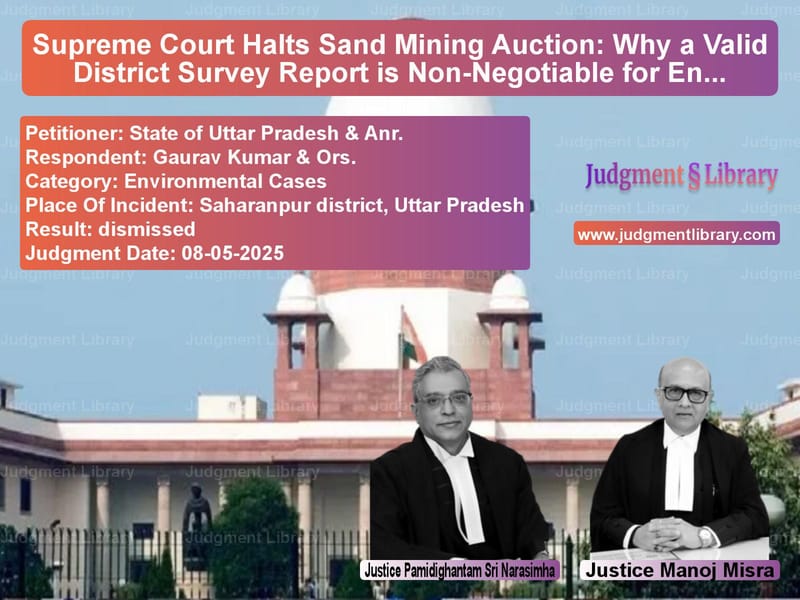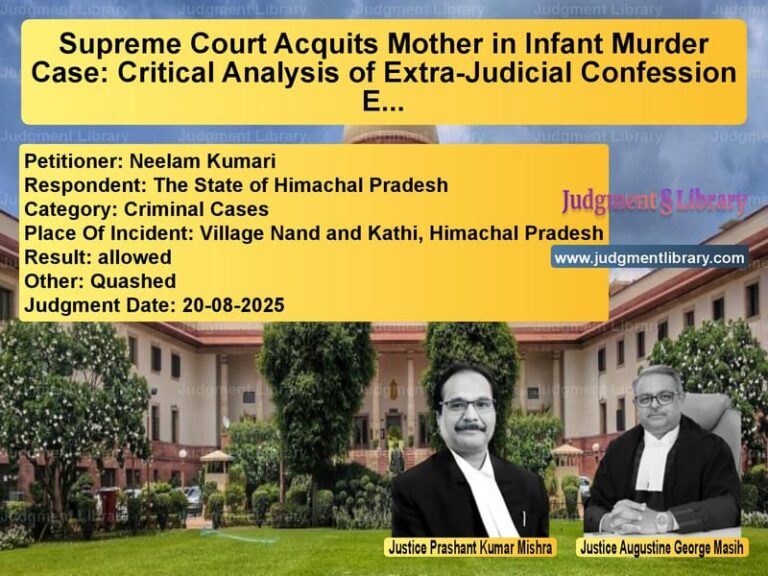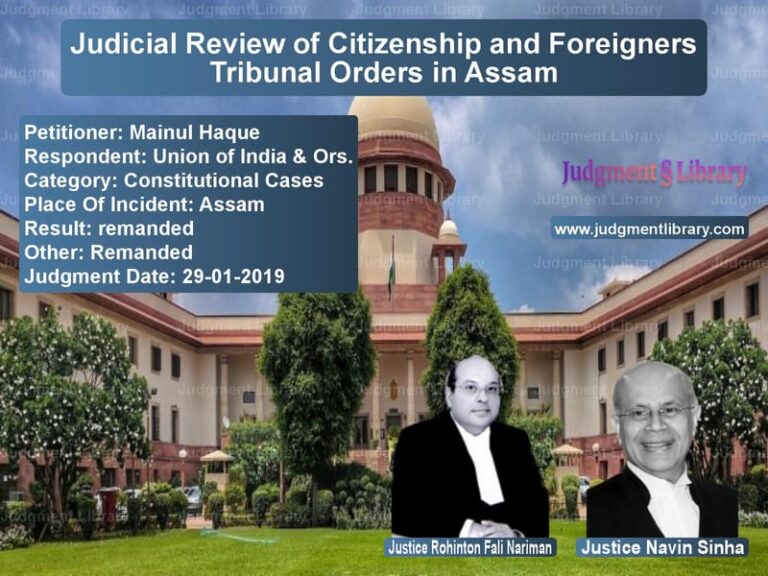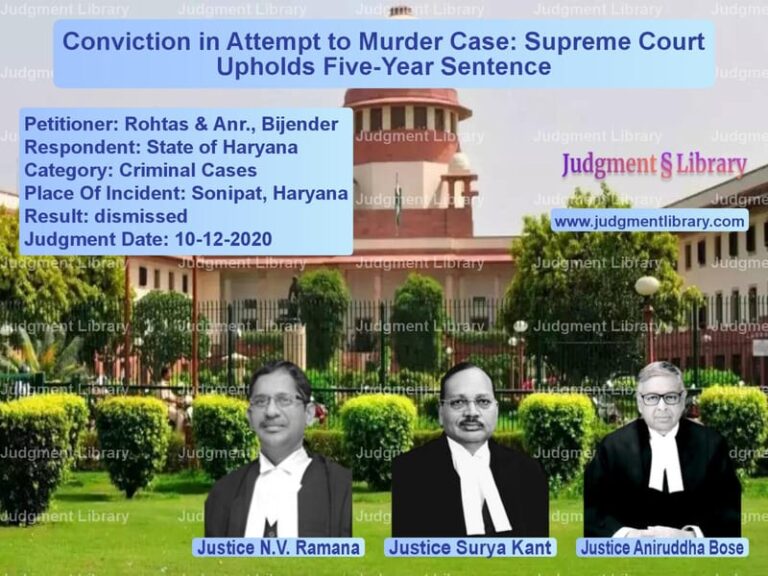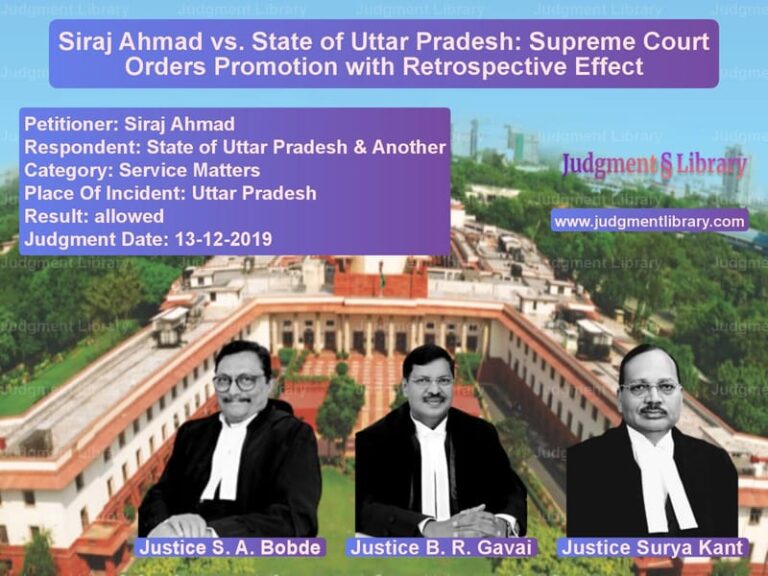Supreme Court Halts Sand Mining Auction: Why a Valid District Survey Report is Non-Negotiable for Environmental Clearance
In a landmark judgment that underscores the critical balance between development and environmental protection, the Supreme Court of India has firmly shut down attempts to conduct sand mining without a valid and finalized District Survey Report (DSR). The case, which saw the State of Uttar Pradesh and several mining companies challenge a ruling by the National Green Tribunal (NGT), culminated in a powerful affirmation of India’s environmental laws. The Court’s decision sends a clear message: there will be zero tolerance for unauthorized sand mining, and strict adherence to regulatory procedures is mandatory.
The core of the dispute revolved around an e-auction notice issued by the District Magistrate of Saharanpur on February 13, 2023. This notice invited tenders for mining sand, gravel, and boulders from the riverbeds in the district. A resident from Haryana, Gaurav Kumar, challenged the legality of this auction before the NGT. His argument was straightforward yet powerful: the auction was illegal because there was no valid District Survey Report in place when the notice was published. The last DSR for Saharanpur district from 2017 had expired in 2022. While a draft DSR had been prepared by January 2023, it had not been finalized before the auction was announced.
The Legal Battle Unfolds
The National Green Tribunal took up the matter seriously, constituting a Joint Committee comprising the Central Pollution Control Board, State Pollution Control Board, and the District Magistrate of Saharanpur to investigate. The committee’s report revealed that despite the absence of a valid DSR, Letters of Interest had been issued for 14 mining sites based on the auction. Interestingly, during the proceedings, the state authorities attempted to rectify the situation by getting the draft DSR approved by the State Expert Appraisal Committee in May 2024 and subsequently by the State Environment Impact Assessment Authority. However, the NGT remained firm in its position that the auction conducted without a valid DSR was fundamentally flawed and quashed it, citing violations of the Environmental Impact Assessment Notification of 2006 and the Enforcement and Monitoring Guidelines for Sand Mining, 2020.
The Supreme Court’s Environmental Concerns
When the matter reached the Supreme Court, the bench delved deep into the environmental implications of unregulated sand mining. The Court expressed grave concerns about how sand mining disrupts riverine ecosystems, alters natural flow patterns, and leads to erosion and habitat loss. The judges noted that aquatic biodiversity suffers as spawning grounds are destroyed and water quality deteriorates. The destabilization of riverbanks increases flooding risks, endangering both human life and animal habitats.
The Court made several crucial observations about the environmental impact of sand mining, stating verbatim: “Unregulated sandmining disrupts riverine ecosystems, alters natural flow patterns, and leads to erosion and habitat loss. Aquatic biodiversity suffers as spawning grounds are destroyed and water quality deteriorates. The destabilisation of riverbanks increases flooding, risking human life and animal habitat alike.”
The judgment also highlighted the alarming rate of global sand extraction, referencing a United Nations Environment Programme study that reported approximately 50 billion tonnes of sand and gravel are removed globally each year. The Court noted that the rate of mining far exceeds natural replenishment rates, creating an ecological imbalance with severe consequences.
The Legal Framework for Sand Mining
The Supreme Court meticulously traced the evolution of environmental regulations governing mining activities in India. Starting from the Environment Protection Act of 1986, which serves as the overarching legislation for environmental protection, the Court examined the various EIA Notifications that have shaped the regulatory landscape.
Read also: https://judgmentlibrary.com/auroville-township-plan-dispute-supreme-court-overturns-ngt-orders/
The EIA Notification of 1994 marked a significant milestone by making environmental clearance mandatory for certain projects, including mining. This was followed by the EIA Notification of 2006, which categorized projects into Category A and B based on their potential environmental impact. However, the pivotal moment came after the Supreme Court’s 2012 decision in Deepak Kumar v. State of Haryana, where the Court deprecated the practice of issuing auction notices without conducting necessary environmental studies.
The Court in Deepak Kumar had observed: “Sand mining on either side of the rivers, upstream and instream, is one of the causes for environmental degradation and also a threat to the biodiversity. Over the years, India’s rivers and riparian ecology have been badly affected by the alarming rate of unrestricted sand mining which damage the ecosystem of rivers and the safety of bridges, weakening of riverbeds, destruction of natural habitats of organisms living on the riverbeds, affects fish breeding and migration, spells disaster for the conservation of many bird species, increases saline water in the rivers, etc.”
The Importance of District Survey Reports
The heart of the current judgment revolves around the mandatory requirement of a District Survey Report. Following the Deepak Kumar case, the government introduced significant amendments through the EIA Notification of 2016, which established District Level Environment Impact Assessment Authority (DEIAA) and District Expert Appraisal Committee (DEAC) for granting environmental clearance to Category B2 projects involving mining of minor minerals with lease areas up to five hectares.
The Court emphasized that the DSR is not merely a procedural formality but a document of seminal importance that enables informed decision-making. Appendix X of the EIA Notification lays down detailed procedures for preparing DSRs, which must identify areas of aggregation where mining can be allowed and areas of erosion where mining should be prohibited. The report must calculate annual replenishment rates and allow time for natural recovery after mining.
The Court made it unequivocally clear that: “A valid and a subsisting DSR alone can be the basis for an application for grant of EC. A draft DSR is untenable for grant of an EC.”
The judgment further elaborated that DSRs have a limited lifespan of five years, after which they must be updated. This requirement recognizes that ecological conditions are dynamic and constantly changing. What was environmentally acceptable five years ago may not be suitable today.
The Court’s Final Ruling
After examining all arguments and the legal framework, the Supreme Court upheld the NGT’s decision to quash the e-auction notice. The Court dismissed all civil appeals filed by the State of Uttar Pradesh and the mining companies, firmly establishing that environmental safeguards cannot be compromised for expediency.
The Court concluded with several key determinations: “Preparation of a DSR as per the procedure prescribed for its preparation under Appendix X, read with para 7(iii)(a), is required to be followed meticulously. Preparation of reports and appraisal of projects by DEIAA and DEAC shall be on the basis of a valid and a subsisting DSR.”
This judgment represents a significant victory for environmental conservation in India. It reinforces the principle that natural resources must be exploited sustainably, with due regard for ecological balance and environmental protection. The Court’s firm stance on requiring a valid DSR before any mining activity can proceed ensures that environmental considerations are integrated into the decision-making process from the very beginning, rather than being treated as an afterthought.
The message from the Supreme Court is clear: development cannot come at the cost of environmental degradation. The strict enforcement of environmental regulations, particularly the requirement for a valid District Survey Report, is essential to protect India’s rivers, ecosystems, and biodiversity from the destructive impacts of unregulated sand mining. This judgment sets an important precedent for future cases involving natural resource extraction and environmental protection, establishing that procedural compliance is not merely technical but fundamental to sustainable development.
Petitioner Name: State of Uttar Pradesh & Anr..Respondent Name: Gaurav Kumar & Ors..Judgment By: Justice Pamidighantam Sri Narasimha, Justice Manoj Misra.Place Of Incident: Saharanpur district, Uttar Pradesh.Judgment Date: 08-05-2025.Result: dismissed.
Don’t miss out on the full details! Download the complete judgment in PDF format below and gain valuable insights instantly!
Download Judgment: state-of-uttar-prade-vs-gaurav-kumar-&-ors.-supreme-court-of-india-judgment-dated-08-05-2025.pdf
Directly Download Judgment: Directly download this Judgment
See all petitions in Environmental Cases
See all petitions in Judgment by P.S. Narasimha
See all petitions in Judgment by Manoj Misra
See all petitions in dismissed
See all petitions in supreme court of India judgments May 2025
See all petitions in 2025 judgments
See all posts in Environmental Cases Category
See all allowed petitions in Environmental Cases Category
See all Dismissed petitions in Environmental Cases Category
See all partially allowed petitions in Environmental Cases Category

